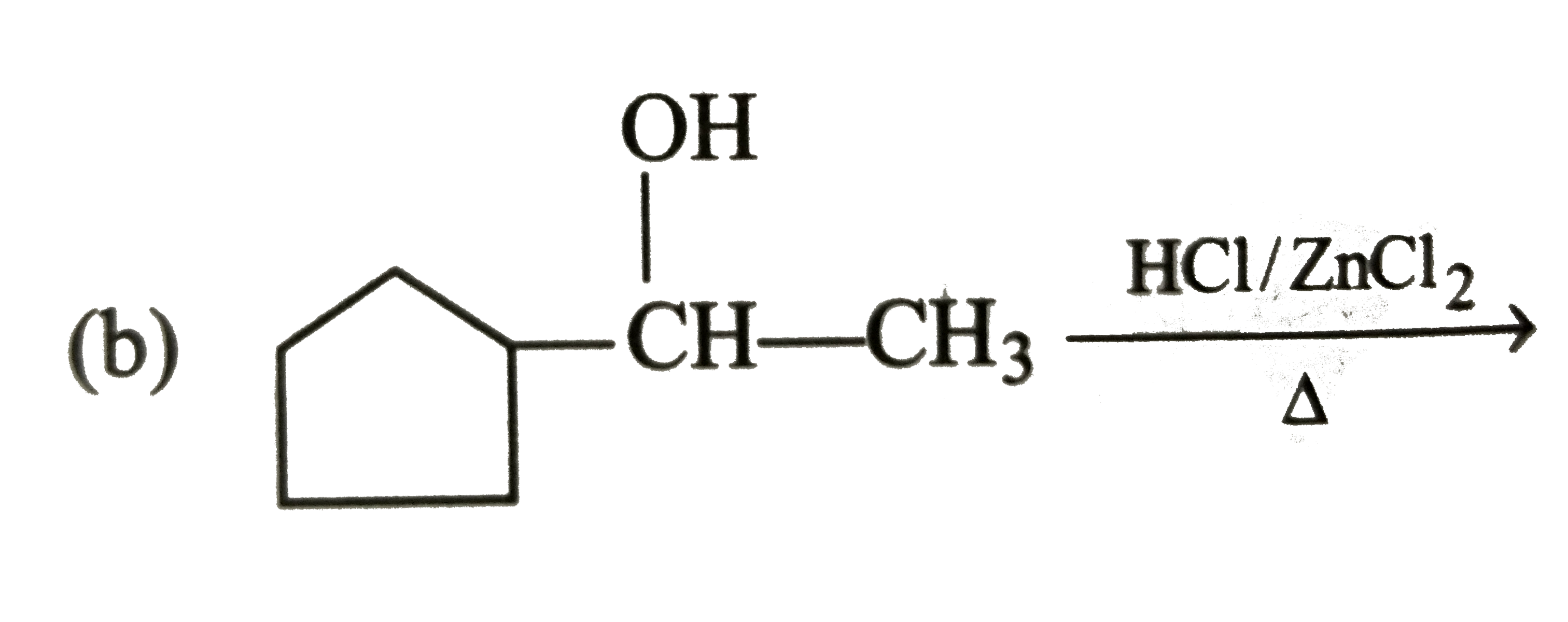Identify the product of the following reaction:
CH3−CH3∣C∣CH3−CH2−BrEtOH−−−→Δ
To identify the product of the given reaction, we will analyze the substrate and the conditions provided. The substrate is a bromoalkane, and the reaction is conducted in the presence of ethanol (EtOH) and heat.
1. Identify the Reaction Type:
The reaction involves a bromoalkane (CH3-CH(CH3)-CH2-Br) reacting with ethanol under heat. This suggests that the reaction will likely proceed via an elimination mechanism, specifically an E1 reaction due to the polar protic solvent and the heat.
Hint: Look for the type of solvent and conditions to determine the reaction mechanism.
2. Formation of Carbocation:
In an E1 reaction, the first step involves the leaving group (Br) departing, which forms a carbocation. The bromine atom (Br) leaves, resulting in the formation of a secondary carbocation at the carbon where Br was attached.
Hint: Identify the leaving group and understand how it affects the substrate structure.
3. Carbocation Rearrangement:
The secondary carbocation can undergo rearrangement. In this case, a methyl group (CH3) can shift from an adjacent carbon to stabilize the carbocation, forming a more stable tertiary carbocation.
Hint: Consider the stability of carbocations and possible rearrangements.
4. Elimination of β-Hydrogen:
After the formation of the stable carbocation, the next step involves the elimination of a β-hydrogen (a hydrogen atom attached to a carbon adjacent to the carbocation). This results in the formation of a double bond.
Hint: Identify β-hydrogens available for elimination.
5. Formation of Alkene:
The elimination of the β-hydrogen leads to the formation of an alkene. In this case, the major product will be the more substituted alkene due to Zaitsev's rule, which states that the more substituted alkene is favored in elimination reactions.
Hint: Apply Zaitsev's rule to determine the major product.
6. Final Product:
The final product of the reaction is an alkene, specifically 2-methylpropene (or isobutylene), which can be represented as CH2=C(CH3)-CH3.
Hint: Verify the structure of the final product to ensure it matches the expected outcome.
Summary of the Product:
The product of the reaction is 2-methylpropene (isobutylene), formed through an E1 elimination mechanism involving the departure of bromine and the subsequent formation of a double bond after the rearrangement of the carbocation.
Final Product:
2-Methylpropene (Isobutylene): CH2=C(CH3)-CH3
The reaction involves a bromoalkane (CH3-CH(CH3)-CH2-Br) reacting with ethanol under heat. This suggests that the reaction will likely proceed via an elimination mechanism, specifically an E1 reaction due to the polar protic solvent and the heat.
In an E1 reaction, the first step involves the leaving group (Br) departing, which forms a carbocation. The bromine atom (Br) leaves, resulting in the formation of a secondary carbocation at the carbon where Br was attached.
The secondary carbocation can undergo rearrangement. In this case, a methyl group (CH3) can shift from an adjacent carbon to stabilize the carbocation, forming a more stable tertiary carbocation.
After the formation of the stable carbocation, the next step involves the elimination of a β-hydrogen (a hydrogen atom attached to a carbon adjacent to the carbocation). This results in the formation of a double bond.
The elimination of the β-hydrogen leads to the formation of an alkene. In this case, the major product will be the more substituted alkene due to Zaitsev's rule, which states that the more substituted alkene is favored in elimination reactions.
The final product of the reaction is an alkene, specifically 2-methylpropene (or isobutylene), which can be represented as CH2=C(CH3)-CH3.
The product of the reaction is 2-methylpropene (isobutylene), formed through an E1 elimination mechanism involving the departure of bromine and the subsequent formation of a double bond after the rearrangement of the carbocation.
2-Methylpropene (Isobutylene): CH2=C(CH3)-CH3
Topper's Solved these Questions
- ALCOHOLS, PHENOLS AND ETHERSBOOK - PRADEEPCHAPTER - ALCOHOLS, PHENOLS AND ETHERSEXERCISE - NCERT QUESTIONS AND EXERCISES WITH ANSWERS (NCERT INTEXT SOLVED QUESTIONS)
7 Videos
- ALCOHOLS, PHENOLS AND ETHERSBOOK - PRADEEPCHAPTER - ALCOHOLS, PHENOLS AND ETHERSEXERCISE - NCERT QUESTIONS AND EXERCISES WITH ANSWERS (NCERT INTEXT UNSOLVED QUESTIONS)
12 Videos
- ALCOHOLS, PHENOLS AND ETHERSBOOK - PRADEEPCHAPTER - ALCOHOLS, PHENOLS AND ETHERSEXERCISE - TEST YOUR GRIP (II. FILL IN THE BLANKS)
37 Videos
- ALDEHYDES, KETONES AND CARBOXYLIC ACIDS BOOK - PRADEEPCHAPTER - ALDEHYDES, KETONES AND CARBOXYLIC ACIDS EXERCISE - IMPORTANT QUESTIONS FOR BOARD EXAMINATION
29 Videos
Similar Questions
Knowledge Check
CH3−Br+NaO−CH3∣C∣CH3−CH3→ ?
ACH3−O−CH3∣C∣CH3−CH3BCH3−CH2∣∣C∣CH3CCH2=CH2DCH3−O−CH∣CH3−CH3The major product formed in the reaction is:
CH3−CH3∣C∣H−CH2BrCH3OӨ−−−−→CH3OHACH3−CH3∣C∣H−CH2OCH3BCH3−C∣OCH3H−CH2CH3CCH3−CH3∣C=CH2DCH3−CH3∣C∣OCH3−CH3The products formed during the following reaction are :
CH3−CH3∣C∣CH3−O−CH3+HI→?ACH3OH+CH3−CH3∣C∣CH3−IBCH4+CH3−CH3∣C∣CH3−OICCH3I+CH3−CH3∣C∣CH3−OHDCH3OI+CH3−CH3∣C∣CH3−H
Explain and complete the following reactions :
CH3−CH2−CH3∣C∣CH3−CH2OHHCl/ZnCl2−−−−−−−−−→Δ (b)
View SolutionWhat are the products of the following reactions?
(a) H3C−CH3∣C∣CH3−Cl+¯¯¯OCH3→
(b) CH3−CH3∣C∣CH3−¯¯¯O+CH3−X→
View SolutionThe major product of the following reaction is:
CH3−CH3∣C∣H−CHCH3∣BrCH3OH−−−−→
View SolutionThe major product formed in the reaction
CH3−CH3∣C∣CH3−CH2..C..l:Ag+−−−−−→H2O
is
View SolutionProduct of the following reaction is -⎡⎢ ⎢⎣CH3−CH3∣N∣CH3−CH∣CH3−CH2−CH3⎤⎥ ⎥⎦+OH−Δ−−→
View Solution
